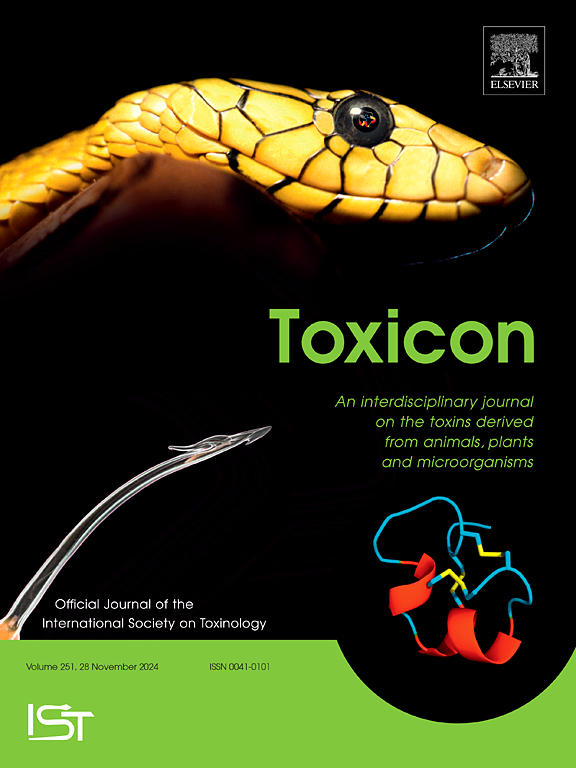Shining a light on the photochemical stability of peptidic bioinsecticides
IF 2.6
4区 医学
Q2 PHARMACOLOGY & PHARMACY
引用次数: 0
Abstract
Peptide toxins from spider venoms are being increasingly hailed as environmentally friendly alternatives to market-dominating small-molecule chemical insecticides. While the stability of knotted spider-venom peptides towards enzymatic degradation, temperature changes and varying pH conditions has already been examined, their susceptibility to sunlight remains unclear. Field applications of insecticides demand that the insecticidal component is active for at least a few days to ensure sufficient eradication of the targeted insect pests. We therefore exposed four insecticidal spider-venom peptides (ω-Hv1a, ω/κ-Hv1a, Ta1a and Dc1a) to continuous artificial sunlight for up to 7 days. After certain incubation periods, we quantified the percentage of intact peptide and identified sites of peptide cleavage. We found that after 3 days of continuous exposure (=6 days of 12 h/d sunlight), the amount of remaining intact peptide was 16 % (Ta1a), 21 % (Dc1a), 55 % (ω-Hv1a), and 67 % (ω/κ-Hv1a), whereas bovine serum albumin was completely degraded. Even after 7 days (=14 days of 12 h/d sunlight) exposure, more than 50 % of ω/κ-Hv1a and ω-Hv1a remained intact. Peptides with lower molecular mass tended to be less susceptible to sunlight, while cleavage of peptide bonds involving proline or cysteine were most susceptible to photochemical degradation. The photochemical changes detected by mass spectrometry mainly comprised oxidations, deamidations, and cysteine-targeted modifications.
多肽类生物杀虫剂光化学稳定性的研究。
从蜘蛛毒液中提取的肽类毒素被越来越多地认为是一种环保的替代品,可以替代市场上占主导地位的小分子化学杀虫剂。虽然已经研究了结状蜘蛛毒液肽在酶降解、温度变化和不同pH条件下的稳定性,但它们对阳光的敏感性仍不清楚。杀虫剂的现场应用要求杀虫成分至少在几天内保持活性,以确保充分消灭目标害虫。因此,我们将四种杀虫蜘蛛毒液肽(ω- hv1a, ω/κ-Hv1a, Ta1a和Dc1a)暴露在连续的人工阳光下长达7天。经过一定的孵育期后,我们量化了完整肽的百分比,并确定了肽切割的位点。我们发现,在连续暴露3天后(= 6天12小时/天的阳光照射),剩余的完整肽量为16% (Ta1a), 21% (Dc1a), 55% (ω- hv1a)和67% (ω/κ-Hv1a),而牛血清白蛋白完全降解。即使经过7天(= 14天12小时/天的阳光照射),ω/κ-Hv1a和ω- hv1a仍有超过50%的完好无损。分子质量较低的肽对阳光的影响较小,而涉及脯氨酸或半胱氨酸的肽键的切割最容易被光化学降解。质谱法检测到的光化学变化主要包括氧化、脱酰胺和半胱氨酸靶向修饰。
本文章由计算机程序翻译,如有差异,请以英文原文为准。
求助全文
约1分钟内获得全文
求助全文
来源期刊

Toxicon
医学-毒理学
CiteScore
4.80
自引率
10.70%
发文量
358
审稿时长
68 days
期刊介绍:
Toxicon has an open access mirror Toxicon: X, sharing the same aims and scope, editorial team, submission system and rigorous peer review. An introductory offer Toxicon: X - full waiver of the Open Access fee.
Toxicon''s "aims and scope" are to publish:
-articles containing the results of original research on problems related to toxins derived from animals, plants and microorganisms
-papers on novel findings related to the chemical, pharmacological, toxicological, and immunological properties of natural toxins
-molecular biological studies of toxins and other genes from poisonous and venomous organisms that advance understanding of the role or function of toxins
-clinical observations on poisoning and envenoming where a new therapeutic principle has been proposed or a decidedly superior clinical result has been obtained.
-material on the use of toxins as tools in studying biological processes and material on subjects related to venom and antivenom problems.
-articles on the translational application of toxins, for example as drugs and insecticides
-epidemiological studies on envenoming or poisoning, so long as they highlight a previously unrecognised medical problem or provide insight into the prevention or medical treatment of envenoming or poisoning. Retrospective surveys of hospital records, especially those lacking species identification, will not be considered for publication. Properly designed prospective community-based surveys are strongly encouraged.
-articles describing well-known activities of venoms, such as antibacterial, anticancer, and analgesic activities of arachnid venoms, without any attempt to define the mechanism of action or purify the active component, will not be considered for publication in Toxicon.
-review articles on problems related to toxinology.
To encourage the exchange of ideas, sections of the journal may be devoted to Short Communications, Letters to the Editor and activities of the affiliated societies.
 求助内容:
求助内容: 应助结果提醒方式:
应助结果提醒方式:


